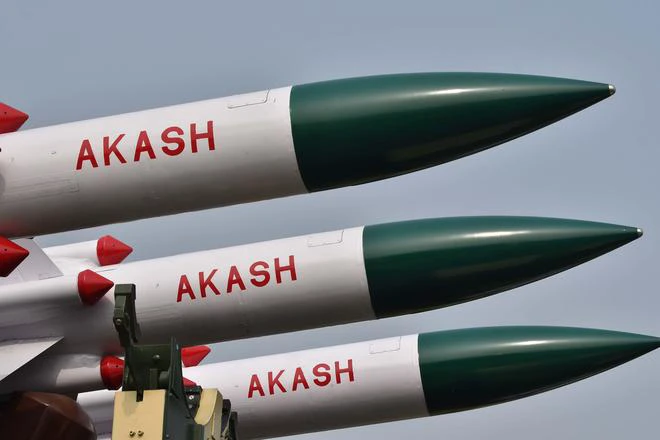Operation Sindoor: Indigenous weapon systems highly effective, says Centre
'All offensive strikes on Pakistan military targets were executed without loss of Indian assets, underscoring the effectiveness of our surveillance, planning, and delivery systems', says Press Information Bureau

Operation Sindoor: The performance of indigenous defence systems against Chinese and Turkish weapon systems stood out during Operation Sindoor. For instance, the indigenous Akash short-range Surface-to-Air systems (SAM) proved their capability, while the Chinese HQ-9 SAMs deployed by Pakistan failed to effectively intercept the precision-guided munitions launched by India.
“All offensive strikes on Pakistan military targets were executed without loss of Indian assets, underscoring the effectiveness of our surveillance, planning, and delivery systems,” the Press Information Bureau (PIB) said on Wednesday (May 14, 2025) about India’s offensive against Pakistani military establishments on May 10.. “The use of modern indigenous technology, from long-range drones to guided munitions, made these strikes highly effective and calibrated,” it said.
The Indian Air Force (IAF) bypassed and jammed Pakistan’s Chinese-supplied air defence systems, completing the mission in just 23 minutes, demonstrating India’s technological edge, the statement said.
Meanwhile, situation along the western borders remained calm on the intervening night of May 13-14 and Army sources said there was schedule as yet for the next round of talks between the Director Generals of Military Operations (DGMOs) of India and Pakistan. As per practice, the DGMOs speak on the established hotline every Tuesday (May 13, 2025).
“India’s defence sector is growing stronger than ever, driven by the spirit of Atmanirbhar Bharat. Defence exports have jumped from ₹686 crore in 2013-14 to ₹23,622 crore in 2024-25 – a 34-fold rise,” Defence Minister Rajnath Singh’s office said on social media.
Operation Sindoor: Express interest
Several countries in southeast Asia, west Asia and Africa have expressed interest in the Akash and BrahMos systems among others, on official noted. “The recent episode is a validation of the performance of these systems in real-time. We anticipate further interest in Indian systems,” he said.
Over the course of five days as Operation Sindoor was launched on the night of May 6-7, the country’s air defence network proved its capability and resilience as Pakistan launched hundreds of drones in waves, Unmanned Combat Aerial Vehicles and missiles inclining high-speed ones most of which were shot down, with only a few making an impact.
The Indian armed forces struck several air defence radar sites, among others, disabling the HQ-15 SAM system in Lahore. The air defence networks of the Army and the IAF were backed by Akashteer air defence and the Integrated Aerial Command and Control Systems (IACCS) respectively.
Operation Sindoor also produced concrete evidence of hostile technologies neutralised by the Indian systems – with the recovery of pieces of Chinese PL-15 air-to-air missiles, Turkish-origin UAVs, long-range rockets, quadcopters and commercial drones, the PIB statement noted. “These were recovered and identified, showing that despite Pakistan’s attempts to exploit advanced foreign-supplied weaponry, India’s indigenous air defence and electronic warfare networks remained superior,” it said.
Pakistan’s defence imports have grown significantly with China emerging the biggest source. Arms imports by Pakistan grew by 61% between 2015-19 and 2020-24, according to the Stockholm International Peace Research Institute. “China became even more dominant as its supplier, accounting for 81% of Pakistan’s arms imports in 2020-24, compared with 74% in 2015-19,” as per its report of March 2025.
The nearly ₹2,000-crore contract for Akashteer, a networking and automation project, was signed in March 2023 and was fielded a year after that. Bharat Electronics Limited (BEL) said on social media that their in-house designed and manufactured Akashteer system had proved its mettle on the war field. “Ground-based defence systems integrated with Akashteer made it hell for Pakistan’s air adventures,” it said on ‘X’. “The system performed beyond users’ expectations, providing robust air defence to India during the current conflict,” it added.
Akashteer ensures a seamless and unified air situation picture accessible to the lowest operational units of Army Air Defence (AAD), enhancing situational awareness across the force, BEL said. Akashteer empowers units on the front lines, enabling dynamic engagement decisions and preventing friendly-fire incidents.
Bringing it all together is a new automation initiative under Project Akashteer, which will build a comprehensive air defence picture for the monitoring, tracking and firing of air defence assets, BEL stated.
Akashteer links all the radars and control centres of AAD and consolidates the air defence picture, removing duplications or overlaps and also integrates all the weapons. The need today is for a comprehensive air defence solution, officials explained, and it can also communicate with the IACCS, forming a comprehensive air picture.
The Army Air Defence – called Air Defence Artillery till 2005 – has been in existence since 1940, though its ground-based air defences have increasingly moved to the Air Force.








